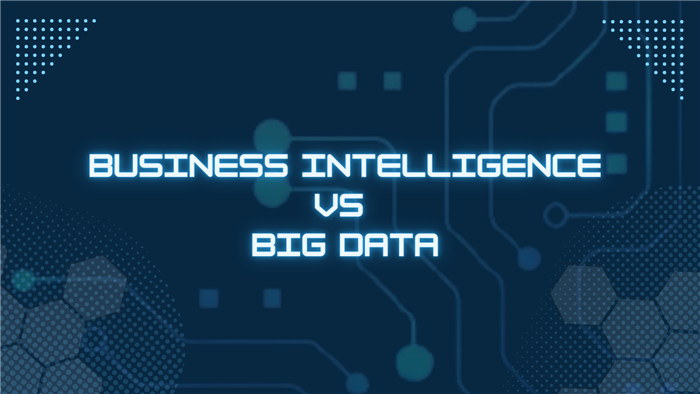Unable to find what you're searching for?
We're here to help you find it
In today's world, data is considered quite important. With the advancement of technology, businesses have gathered a vast amount of data in different forms.
The abundance of data has made it possible to perform various analytical operations. It has helped businesses to make informed decisions. However, when working with data, two terms often come up: "big data" and "business intelligence." It is crucial to understand both concepts and be able to differentiate between them.
This blog post will discuss the differences between big data and business intelligence.
| Key Differences | Big Data | Business Intelligence |
| Data Volume and Variety | Deals with large and complex unstructured data | Deals with structured data typically stored in data warehouses |
| Data Processing | Processes and analyzes large volumes of unstructured data using technologies such as Hadoop, Spark, and NoSQL databases | Analyzes structured data and creates reports and visualizations using BI tools |
| Data Storage | Uses distributed file systems such as HDFS to store data | Uses data warehousing to store structured data |
| Analysis Techniques | Uses MapReduce and machine learning to analyze unstructured data | Uses OLAP and data mining techniques to examine structured data |
| Time Sensitivity | Typically real-time or near real-time as it deals with high velocity data | Analysis is typically done on historical data and may not be time-sensitive |
| Business Goals | Used to discover new insights and opportunities | Monitors performance and makes informed decisions |
Big data refers to the large volume of structured, semi-structured, and unstructured data businesses collect daily. It is a term used to describe data that is too large and complex to be analyzed by traditional methods. The four "Vs" that characterize big data are volume, velocity, variety, and veracity. Volume refers to the size of the data, and velocity is the speed at which it is generated and collected. Variety refers to the different types of data, and veracity is the accuracy and quality of the data.
To give an example, consider a social media platform like Facebook. Millions of people use Facebook to post, share, and interact with others daily. It generates vast data, including text, images, videos, and more. This data is too large and complex to be analyzed by traditional methods. However, big data technologies process and interpret this data easily and quickly.
Business Intelligence (BI) refers to transforming data into actionable insights that help businesses make informed decisions. It is a set of tools and techniques that organizations use to analyze data and create reports, dashboards, and visualizations that provide insights into their performance. BI tools typically include data visualization, data warehousing, and online analytical processing (OLAP).
To give an example, consider a retail store. The store collects data on sales, inventory, and customer behavior. This data is used to create reports and dashboards that provide insights into the store's performance. For instance, the store might analyze sales data to determine which products are selling the most and which are not. This information can be used to optimize inventory and make informed decisions about marketing and promotions.
| Pros | Cons |
| Discover New Insights: Big data analysis can help businesses discover new patterns and insights that may not be apparent with traditional data analysis techniques. It can lead to new opportunities for growth and innovation. | Complexity: Big data technologies can be complex and require specialized skills and expertise to implement and manage. |
| Real-time Analysis: Big data analysis can be done in real-time or near real-time, which can help businesses make timely decisions. | Security Risks: Big data can contain sensitive information. Thus, businesses must take measures to ensure the security and privacy of their data. |
| Scalability: These technologies are designed to handle large volumes of data and can scale up or down as needed. | Data Quality: Big data can contain errors, which can impact the accuracy of analysis results. |
| Cost-effective: Big data technologies are often open-source and more cost-effective than traditional data analysis methods. | Integration Challenges: Integrating big data technologies with existing systems can be challenging and require significant effort and resources. |
| Improved Customer Experience: Big data analysis can help businesses understand their customers better and provide a more personalized experience. | Regulatory Compliance: Big data analysis can be subject to regulatory compliance requirements, such as GDPR (General Data Protection Regulation), which can be complex and time-consuming to implement. |
| Predictive Analytics: Big data analysis can help businesses predict future trends and outcomes, improving their decision-making processes. | Lack of Expertise: Implementing and managing big data technologies requires specialized skills and expertise that may not be readily available within the organization. |
| Competitive Advantage: By using big data analysis, organizations can gain a competitive advantage by identifying opportunities and enhancing their operations and customer experience. | Integration Challenges: Integrating big data technologies with existing systems can be complex and challenging, requiring significant time and resources. |
| Pros | Cons |
| Improved Decision-making: BI tools can provide businesses with valuable insights into their performance, improving their decision-making process. | Limited Scope: BI tools are typically used to analyze structured data and may not be suitable for examining unstructured data. |
| Historical Analysis: BI analysis is typically done on historical data, which can help businesses identify trends and patterns over time. | Time Sensitivity: BI analysis is typically done on historical data and may not be time-sensitive. |
| Easy to Use: Many BI tools are user-friendly and do not require specialized skills or expertise. | Integration Challenges: Integrating BI tools with existing systems can require significant effort and resources. |
| Standardization: BI tools provide a standardized way of analyzing data, which can help businesses ensure consistency and accuracy. | Data Quality: BI analysis is only as good as the quality of the data being interpreted. Data quality issues can impact the accuracy of analysis results. |
| Scalability: BI tools can scale up or down as needed to meet the changing needs of the business. | Cost: BI tools can be expensive. Businesses must weigh the costs against the potential benefits. |
| Cost Savings: BI analysis can help businesses identify cost savings opportunities by specifying areas of inefficiency or waste. | Limited Flexibility: BI tools may be unable to accommodate ad hoc analysis or changing business needs, limiting their usefulness in dynamic business environments. |
| Improved Customer Experience: By studying customer data, businesses can better understand customers' needs and preferences and improve their experience. |
Both big data and business intelligence have pros and cons, and the choice between them depends on the organization's specific needs and goals. They can provide valuable insights and help organizations make knowledgeable decisions, but they require different skills, resources, and infrastructure to implement and manage. Ultimately, businesses should evaluate their data needs and capabilities and choose the best approach for their situation.
The choice between big data and business intelligence depends on the type of business and the specific goals and needs of the organization. Both big data and business intelligence can provide valuable insights and help businesses make informed decisions.
Big data technologies may be more appropriate if your business deals with large volumes of unstructured data, such as social media or sensor data. It can help you identify patterns and insights that may not be apparent with traditional data analysis techniques.
On the other hand, if your business deals with structured data, such as sales or financial data, then business intelligence may be more appropriate. BI tools can help you create reports and visualizations that provide insights into your organization's performance and help you make informed decisions.
It's worth noting that big data and business intelligence are not mutually exclusive. Many organizations use both to gain a more comprehensive view of their data and make better decisions.
Must Read: Big Data and Cloud computing: An Ideal Combination
The key difference between big data and business intelligence is the type of data analyzed and the techniques and tools used for analysis. The choice between the two depends on the specific needs and goals of the organization. In today’s digital and fast-paced world, many businesses may benefit from using both techniques.

Archer Charles has top education industry knowledge with 4 years of experience. Being a passionate blogger also does blogging on the technology niche.










